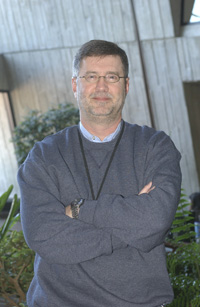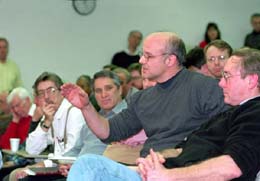 |
|
Data Make You Smarter by Dan Amidei, University of Michigan As Collider Run II gets under way with fits and starts it ’s becoming fashionable to question its goals. But it would be wrong to pre-judge this program. History shows us why. The aggressive plan for Run II began in 1995-96 when a rag-tag group of users pulled together the tev_2000 workshop which studied the physics case for extended running of the Tevatron. Previously,SSC preparation had overshadowed the high transverse momentum (“high-p T ”)potential of a Fermilab program. However,with the cancellation of the SSC and the top quark discovery imminent,the discounted Tevatron began to present a certain attractiveness …
AULD LANG SYNE In 1996,that message was the unpredictability inherent in a broad research program.When we propose experiments we set goals and use them to evaluate results —an understandable process,up to a point.But as empirical scientists,it behooves us to remember what has been demonstrably true over the decades:in HEP,as in all science,surprises happen .In 1996 we chose to make that point with two classic surprises that … “…illustrate a feature of research which deserves protection when future plans are considered.These surprises …are the long lifetime of B hadrons and the extreme large mass of the top quark.The efforts which eventually led to these understandings didn ’t come from strategic leaps,rather they came from the accumulation of experimental results and techniques over time …no accelerators were proposed,planned,or constructed to make these discoveries.Hints and leads were followed over many years which eventually bore fruit.”
HISTORY LESSON
The two examples we cited had already had important implications for research and detector technology. Again, from the report: “The bottom quark and top quark stories … represent the usual path toward scientific breakthrough.‘Throwing long ’is a strategy which has a place as a component of a broad, stable physics program.However,it cannot dominate …As much as anything in science can come with a guarantee,success and surprise seem repeatedly to be the eventual outcomes of the Evolutionary approach in high energy physics.This sort of success doesn ’t happen accidentally.Rather [it comes ]…by the mounting of topical experiments which attract the brightest scientists …and the means to do those experiments in a timely way.We call this Following the Physics,as decidedly distinct from ‘waiting for the physics.’” On re-reading,it was satisfying to discover that the tev_2000 report itself,unwittingly,made our point. Two examples: First,to be sure,many of us came to this work convinced of the importance of a high p T program at Fermilab.A critical Run II benchmark was the characterization of the top quark and we had reason to be persuasive on that score.How precisely could we determine its mass?We reached the proud conclusion that it ’s uncertainty would be as little as ±13.5 GeV/c2 ,or ~8%. However,when truly beautiful data and real backgrounds were paired with reliable detectors and hundreds of cunning and motivated physicists,CDF and DZero eventually achieved an uncertainty of roughly ±5 GeV/c 2 ,from only a handful of top quarks.Detailed understanding of detector responses,competitive crosstalk between the collaborations,and the exploitation of new analysis techniques led to a precision better than twice what we predicted.Surprises happen: the data made us smarter. Second, the mass of the W boson is a significant component in constraining the Higgs boson mass within the Standard Model. Estimating the Run I mass uncertainty was easy: it’s all statistical and so we knew we could expect a precision better than about 0.1 percent. That’s essentially what we found. But, after analysis of Run I data, the central value of the W boson mass shifted more than a full standard deviation higher than the 1995 value. In turn, this surprise led to the expectation that in order for the Standard Model to be consistent, the Higgs boson mass must be much lower than anyone had anticipated. Once again: Surprises happen .
We ’ve cited two sorts of surprises.The precision of the top quark mass is of the “data make you smarter ”sort.There is nothing more stimulating than the mix of committed physicists,real data and fertile imaginations.This kind of progress under battlefield conditions cannot be generated in workshop settings or Monte Carlo simulation. Real data and competition are required ingredients. In contrast,the second example was arranged by nature and statistics.Even though the shift of M W was consistent with earlier measurements, the consequences were so dramatic that it also constituted a surprise. Plugging these two results into the Standard Model changed everyone ’s expectations about the Higgs boson:the expectation that the probable window for the Higgs mass could be as low as 100 GeV/c 2 has become the norm and guides current experimental programs. Two sorts of surprise — one resulting from cleverness and stress and the other from aggressively pursuing measurements to extreme precision.We can add a third sort,the “who ordered that?”shock that comes from stumbling across unanticipated results.When people think about scientific surprises, it’s this kind that usually comes to mind. Program planning must preserve the opportunity for all three sorts of surprise. From history we know they are likely — even probable. HIGGS AS SOUND BITE The tev_2000 workshop addressed prospects for discovery of a light Higgs boson. Two theoretical papers had appeared predicting that the Higgs might be produced with W or Z bosons and occur at a surprising rate — requiring significant, but conceivable, Tevatron luminosity. (These predictions were a surprise of their own, given all of the previous ink spilled describing weaker Higgs discovery channels.)These experimental signatures would stand out and benefit from the well-studied top quark detection tools.The tev_2000 Higgs group cautiously simulated a single detection strategy using conservative estimates for the evolution of future tagging and mass resolution capabilities and found a surprising sensitivity for discovery. This combination of events illustrates a crucial point.The straw-scenario of the light Higgs went from “unlikely ”to “probable ” because of work of five free-thinking theorists,a handful of workshop soldiers and the unexpected Run I top quark and W boson results.With a follow-on workshop,the Higgs search at Fermilab became a high profile target,one with a name and a straightforward strategy.Great,right? In fact, Run II luminosity has been slow to reach design levels and impatience and second guessing can be heard.The Higgs search is a clean,simple- sounding goal,an easy sound bite.It ’s great for the Higgs to gain congressional attention,but we risk being hoist by our own petard.Should the Higgs become the only theme of Run II,and if the Run II luminosity situation is prematurely judged to be lacking,then Run II ’s history could be written before even the first fb -1 of data are on disk.There are at least two problems with such thinking. First, Monte Carlo sensitivity studies can’t be naively applied as sole performance measures for the real lives of these complex experiments. Suppose that before Run I in the late 1980’s, the Physics Advisory Committee had decided that a top quark mass resolution of our eventual ~5 GeV/c 2 was the minimally acceptable target.The required Run I running period would have had to be much longer,probably compromising its approval.But, real science,with real data,made us smarter — worth a significant luminosity bonus.The Higgs search scenario envisioned for Run II came from just those sorts of studies that produced the 13.5 GeV/c 2 top quark mass prediction. Second,while the luminosity performance has been disappointing,from our tev_2000 perspective we note that in the past 5 months,the Tevatron has essentially duplicated the Run I dataset,which originally took four difficult years.This necessary rate of improvement demonstrates that data are making everyone smarter.Although we are not yet where we want to be,we are way ahead of where we were,and gaining.
APPLIED HISTORY With the past as guide —a guide better than anyone ’s prediction for untried,unrealized devices —if the Higgs boson is there and if a significant fraction of the luminosity goal is delivered,then the same hundreds of people that defied the odds on the top quark mass will focus their manic energies to find this elusive, critical state of matter.We think the odds are high that Higgs hints,discovery or elimination, will occur before the original tev_2000 discovery threshold.In pace with direct research,even more precise measurements of m t and M W by experienced groups with seasoned detectors will constrain the Standard Model. If it ’s not there? DZero and CDF will determine that too,and give electroweak symmetry breaking in the Standard Model its first crack in 25 years. A realistic estimate for the duration of Run II is that it will encompass the better part of the decade.In this long run the Higgs is only a part of the whole story —recall our surprises,especially the third sort.The figure shows integrated luminosity milestones and the physics payoff at each level.This is a broad program,with precision measurements and discovery potential in multiple subjects.The physics sensitivity increases as we accumulate data, understand the detectors and backgrounds and optimize the complex for luminosity.Does anyone really believe that nothing significant and unpredicted will happen in Run II prior to a Higgs bosons signal?Run I, which so greatly affected how we look at HEP today,is only a small sliver of the whole of Tevatron chronology.A decade with no surprises would be the first such decade in the history of high energy physics. What about the luminosity?Well,taming the complexity in commissioning and running modern particle accelerators is at the edge of the humanly possible. Remember the startup of the SLAC SLC?Heroic efforts in commissioning and running of that complicated machine eventually paid huge physics dividends,but not without early community impatience.But we stuck with it. We suggest the same will be true with the Tevatron.Run II started out with a set of new machines to be understood,commissioned and integrated into an optimized facility.As the Beams Division people bring the various elements of the Run II complex to operational status,the data will make them smarter, and the luminosity will continue climbing.We ’re convinced that Tevatron Run II is going to deliver;and so again,we need to stick with it. With a future international HEP program of incredible richness facing falling annual support for physical science,the demands ahead in the U.S.,Europe, and Japan stretch our resources and personnel.The Monte Carlo future can always be made to look more attractive than the unpleasantness of a present burdened with real data and real challenges.However,given the history of surprise that we have outlined and the thousands of scientist-years and hundreds of millions of dollars expended in Run II preparation,prejudging it would be irresponsible.In the extreme,simply performing experiments for which the outcome is certain is not what we do.Rather,we need to keep faith in the plans we have laid out and hope that our sponsors will continue to support us in the pursuit of whatever surprises are in store,including the Higgs boson.Remember,nature repeatedly reveals itself through patient experimentation,and the most likely product is surprise . Respond online at http://www.fnal.gov/pub/ferminews/interactions/index.html or send email to FermiNews
REFERENCES
Title:Possible Detection of a Higgs Boson at
Higher Luminosity Hadron Colliders
|


